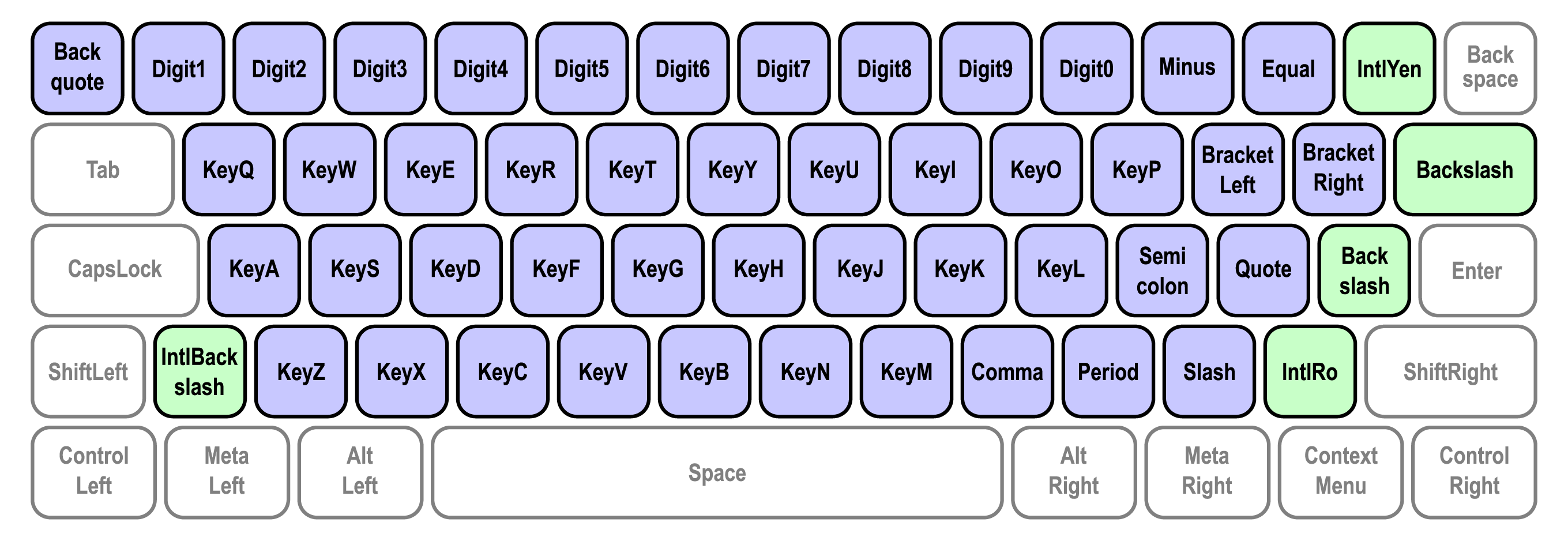Keyboard API
Experimental: This is an experimental technology
Check the Browser compatibility table carefully before using this in production.
The Keyboard API provides methods for working with a physical keyboard that is attached to a device running a browser.
It provides several capabilities. Keyboard mapping provides an interface for retrieving the string generated by particular physical key on a keyboard to correctly identify that key to a user. Keyboard locking enables a web page to capture keys that are normally reserved by the user agent or the underlying operating system. The intended use of the Keyboard API is by web applications such as games or remote access apps that provide a fullscreen immersive experience.
Keyboard API concepts and usage
Keyboard mapping
On physical keyboards, the code attribute contains the physical location of the key that was pressed, and the key attribute contains the string generated by pressing the key at that physical location on the keyboard. The key value takes into account the keyboard's locale (for example, 'en-US'), layout (for example, 'QWERTY'), and modifier-key state (Shift, Control, etc.). Historically there has been no way to retrieve that information.
The Keyboard Map API provides a way to retrieve the string generated by a particular key press, through the Keyboard interface and the KeyboardLayoutMap interface. The Keyboard interface is accessed through navigator.keyboard. Keyboard provides the Keyboard.getLayoutMap method, which returns a promise that resolves with a KeyboardLayoutMap object that contains members for converting codes to keys. A list of valid code values is found in the Writing System Keys section of the UI Events KeyboardEvent code Values spec.
The following example demonstrates how to get the location-specific or layout-specific string associated with the key labeled W on an English QWERTY keyboard.
if (navigator.keyboard) {
var keyboard = navigator.keyboard;
keyboard.getLayoutMap()
.then(keyboardLayoutMap => {
var upKey = keyboardLayoutMap.get('KeyW');
window.alert('Press ' + upKey + ' to move up.');
});
} else {
// Do something else.
}
Keyboard locking
Richly interactive web pages, games, and remote-streaming experiences often require access to special keys and keyboard shortcuts while in fullscreen mode. Examples of such key/key combinations include Escape, Alt+Tab, and Ctrl+N. Those keys and key combinations are typically captured by the user agent or the underlying operating system, as illustrated in the following example.
To capture the "W", "A", "S", and "D" keys, call lock() with a list that contains the key code attribute value for each of these keys:
navigator.keyboard.lock(["KeyW", "KeyA", "KeyS", "KeyD"]);
This captures these keys regardless of which modifiers are used with the key press. Assuming a standard United States QWERTY layout, registering KeyW ensures that "W", Shift+"W", Control+"W", Control+Shift+"W", and all other key modifier combinations with "W" are sent to the app. The same applies to for KeyA, KeyS and KeyD.
Writing system keys
The codes passed Keyboard.lock and the various methods of the KeyboardLayoutMap interface are called "writing system keys".
"Writing system keys" are defined in the Writing System Keys section of the UI Events KeyboardEvent code Values spec as the physical keys that change meaning based on the current locale and keyboard layout. These keys are shown below. Blue keys are present on all standard keyboards while green keys are only available on some keyboards.

Interfaces
Keyboard-
Provides functions that retrieve keyboard layout maps and toggle capturing of key presses from the physical keyboard.
KeyboardLayoutMap-
A map-like object with functions for retrieving the string associated with specific physical keys.
-
Returns a
Keyboardobject which provides access to functions that retrieve keyboard layout maps and toggle capturing of key presses from the physical keyboard.
Specifications
| Specification | Status | Comment |
|---|---|---|
| Keyboard Map | Editor's Draft | Initial definition. |
| Keyboard Lock | Editor's Draft | Initial definition. |
Browser compatibility
Keyboard API
BCD tables only load in the browser
Keyboard lock API
BCD tables only load in the browser